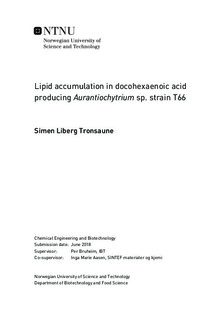Lipid accumulation in docohexaenoic acid producing Aurantiochytrium sp. strain T66
Master thesis
Permanent lenke
http://hdl.handle.net/11250/2615539Utgivelsesdato
2018Metadata
Vis full innførselSamlinger
Sammendrag
Docohexaenoic acid (DHA), one of the omega-3 fatty acids, is an essential nutrient for human, animal and fish health. The DHA production from fish oil resources is associated with several negative features, and microbial DHA production has emerged as a sustainable and promising alternative. Extensive screening of thraustochytrids, including the genus Aurantiochytrium, has yielded strains producing more than 70% lipids of dry cell weight, and DHA comprising more than 50% of the total fatty acids (TFA).
Aurantiochytrium sp. strain T66 was grown in a bioreactor and shake-flask cultures with glutamate-glucose as carbon sources. Profiling of intracellular lipids, fatty acids, and central metabolites was performed to develop the knowledge regarding T66 as a potential DHA producer. Sampling protocol development was a central part of this work, and was performed to establish robust and reproducible protocols for qualitative analyses of intracellular metabolites (IM). The analyses of IM provided important remarks on proposed limiting factors of lipid biosynthesis.
Exponentially growing cells in the bioreactor culture, showed a lipid content of 20% of dry cell weight, increasing to 69% during the lipid accumulation phase, initiated by N-limitation at 92 hours. The dry biomass concentration was 27 g/l after 161 hours, with an overall DHA productivity of 16 mg DHA/l/h. Neutral (NL) and polar lipids (PL) were the two major lipid groups of total lipids (TL), with TAGs constituting more than 90% of TL during the lipid accumulation phase. In contrast, only 5% of the TL was phospholipids, but this class remained stable at 5% throughout the lipid accumulation phase. The NL and PL were separated by solid phase extraction, and the FA profiles of the two lipid groups were determined and compared. The concentrations of all fatty acids (FA) increased throughout the cultivation, showing a decreased fraction of saturated FA (SFA), and developing portions of monounsaturated FAs (MUFAs) and polyunsaturated FAs (PUFAs) of TFA.
A shake-flask pilot study was performed to test if shake-flasks was a relevant model system, and could be used as an alternative to bioreactor cultivations for expensive 13C-label experimentation. The results indicated minor differences in metabolic fluxes in the upper glycolysis and the pentose phosphate pathway during growth and the lipid accumulation phase, i.e. glutamate carbon did not entering the glycolytic pathway via anaplerotic reactions during the growth phase with glutamate still present.
Additionally, the life-cycle of Aurantiochytrium sp. strain T66 was explored to observe the co-existence of zoospores and vegetative cells. Zoospore-release from a mature zoosporangium was caught on film, and staining provided information demonstrating high metabolic activity during zoospores settlement.
This MSc project contributed with improving experimental protocols, generated new biological data, that collectively will be important for future work towards optimizing DHA production in thraustochytrids.
